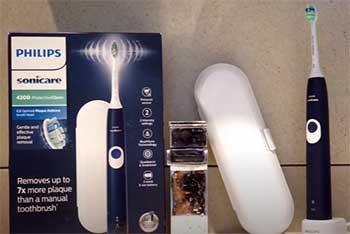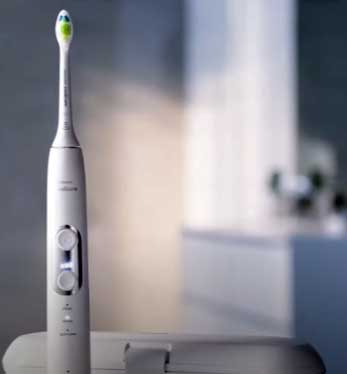When it comes to choosing the right electric toothbrush, the options can be overwhelming. Two popular models from Philips, the Sonicare 4300 and Sonicare 6100, have caught the attention of many. But which one should you pick?
In this article, I’ll walk you through a detailed comparison of these two models, covering their features, pros and cons, and ultimately helping you decide which one is the best fit for your oral care needs.
A Brief Comparison Table
| Feature | Sonicare 4300 | Sonicare 6100 |
| Cleaning Modes | 1 mode (Clean) | 3 modes (Clean, White, Gum Care) |
| Brush Head Compatibility | Standard Sonicare Heads | Standard Sonicare Heads |
| Pressure Sensor | Yes | Yes |
| Battery Life | Up to 2 weeks | Up to 2 weeks |
| Brush Pacer | Yes | Yes |
| BrushSync Technology | Yes | Yes |
| Intensity Settings | No | 3 intensity settings |
| Smartimer | Yes | Yes |
| Travel Case | No | Yes |
| Price | Affordable | Higher-end |
Pros And Cons of Sonicare 4300 Toothbrush
Pros:

- Affordability: One of the biggest advantages of the Sonicare 4300 is its cost-effectiveness. It provides high-quality cleaning without breaking the bank.
- Pressure Sensor: This feature helps protect your gums by alerting you if you’re brushing too hard.
- BrushSync Technology: The brush head replacement reminder ensures you’re always using an effective brush head.
- Easy to Use: With just one cleaning mode, it’s straightforward and user-friendly.
Cons:
- Limited Features: The 4300 offers only one cleaning mode, which may not cater to all your dental care needs.
- No Travel Case: If you travel frequently, the lack of a travel case can be inconvenient.
- No Intensity Settings: You can’t adjust the intensity, which might be a drawback if you prefer customizable brushing experiences.
Pros And Cons of Sonicare 6100 Toothbrush
Pros:

- Multiple Cleaning Modes: With three modes (Clean, White, Gum Care), you can tailor your brushing to your specific needs.
- Intensity Settings: The 6100 allows you to adjust the intensity, offering a more personalized brushing experience.
- Travel Case Included: This makes it convenient for those who travel often.
- BrushSync Technology: Just like the 4300, it reminds you to change your brush head for optimal performance.
- Comprehensive Care: The additional modes and settings make it a more versatile choice for thorough oral care.
Cons:
- Price: The 6100 is more expensive, which might not fit everyone’s budget.
- Complexity: With more features, it can be a bit more complicated to use, especially for those who prefer simplicity.
Also Read: Differences Between Oral-B Pro 1000 And Pro 500 Toothbrush.
Detailed Comparison of Sonicare 4300 And 6100 Toothbrushes

- Cleaning Modes and Intensity Settings
The Sonicare 4300 comes with a single cleaning mode, which is the standard Clean mode. This mode is sufficient for regular brushing but doesn’t offer specialized care for whitening or gum health.
On the other hand, the Sonicare 6100 boasts three cleaning modes: Clean, White, and Gum Care. The White mode is designed to remove surface stains, while the Gum Care mode provides a gentle massage to improve gum health.
Additionally, the 6100 offers three intensity settings, allowing you to customize your brushing experience based on your comfort level.
In my experience, the flexibility offered by the 6100’s multiple modes and settings can be a game-changer, especially if you have specific oral care goals. However, if you prefer a straightforward brushing routine without the need for customization, the 4300’s simplicity might be more appealing.
- BrushSync Technology
Both the 4300 and 6100 feature BrushSync technology, which is a significant advantage. This technology ensures that you always use an effective brush head by reminding you when it’s time for a replacement.
It also automatically selects the optimal mode and intensity for the brush head in use (in the case of the 6100). This feature simplifies your brushing routine and ensures consistent, optimal performance.
- Battery Life and Charging
Battery life is crucial for convenience, especially if you’re often on the go. Both models offer up to two weeks of battery life on a single charge, which is impressive.
However, the Sonicare 6100 includes a travel case that makes it easier to carry your toothbrush and charger while traveling. The 4300, lacking this feature, may require more planning if you’re frequently away from home.
- Pressure Sensor
A common issue with electric toothbrushes is the potential for brushing too hard, which can damage your gums. Both the 4300 and 6100 come with a pressure sensor that alerts you when you’re applying too much pressure.
This feature is incredibly beneficial in promoting healthier brushing habits and protecting your gums from damage.
- Price and Value

Price is always a consideration when choosing between models.
The Sonicare 4300 is more affordable, making it a great choice for those on a budget or for first-time electric toothbrush users.
The 6100, while more expensive, offers additional features that may justify the higher price for some users.
If you value customization and travel convenience, the extra cost might be worth it.
However, if you’re looking for a cost-effective solution that still provides excellent cleaning, the 4300 is a solid choice.
Also Read: Is Oral-B Pro 1000 Better Than Philips Sonicare 4100?
Frequently Asked Questions (FAQ)
It depends on your needs. The 4300 is more affordable and straightforward, while the 6100 offers more features and customization for a higher price.
The Sonicare 6100 was released in 2018, bringing advanced features and multiple cleaning modes to the Sonicare lineup.
The best model depends on your specific needs and preferences. The Sonicare 6100 is great for those who want multiple features, while the 4300 is perfect for those looking for a more affordable option.
No, the Sonicare 4100 and 4300 are different models. The 4300 includes BrushSync technology and a pressure sensor, which are not available in the 4100.
Wrapping Up
Deciding between the Sonicare 4300 and 6100 depends on your personal preferences and needs. If you’re looking for an affordable, straightforward toothbrush that gets the job done, the 4300 is a fantastic option.
However, if you want more features, such as multiple cleaning modes, intensity settings, and a travel case, the 6100 offers greater flexibility and convenience.
In my personal experience, both models deliver excellent cleaning performance, but the 6100’s added features provide a more tailored and comfortable brushing experience. Consider what aspects are most important to you—whether it’s price, simplicity, or advanced features—and choose accordingly.
By understanding the differences between these two models, you can make an informed decision that best suits your oral care routine.
